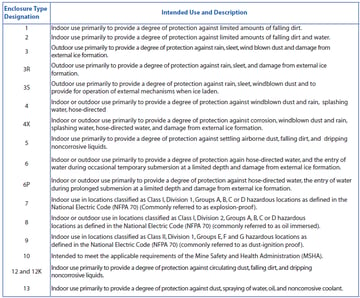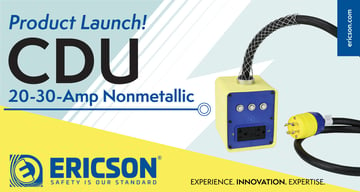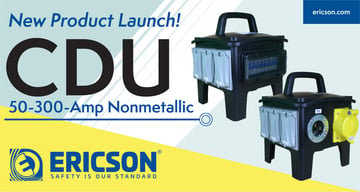September 11, 2018
What do NEMA Enclosure Designations Mean? Ericson Has the Answer!
Written by: Jeff Angle
The National Electrical Manufacturers Association (NEMA) was founded in 1926, and is headquartered in Rosslyn, VA. NEMA is the association of electrical equipment and medical imaging manufacturers and has almost 350 members. Its members manufacture a range of products, including power transmission and distribution equipment, lighting systems, factory automation and control systems, and medical systems. In addition, NEMA publishes more than 600 standards, application guides, white papers, and technical papers.
NEMA has various designations to provide general information on the definitions of NEMA Enclosure Types to architects, engineers, installers, inspectors and other interested parties. These enclosure type designations are not to be confused with NEMA wiring device designations, such as NEMA 5-15, NEMA L5-20, etc. See NEMA standard WD-6 for more information about those. When installed properly, the specific enclosure types, their applications, and the environmental conditions they are designed to protect against are listed below:
| Enclosure Designation | Intended Use and Description |
| 1 | Indoor use primarily to provide a degree of protection against limited amounts of falling dirt |
| 2 | Indoor use primarily to provide a degree of protection against limited amounts of falling dirt and water |
| 3 | Outdoor use primarily to provide a degree of protection against rain, sleet, wind blown dust and damage from external ice formation |
| 3R | Outdoor use primarily to provide a degree of protection against rain, sleet, and damage from external ice formation |
| 3S | Outdoor use primarily to provide a degree of protection against rain, sleet, wind blown dust and to provide for operation of external mechanisms when ice laden |
| 4 | Indoor or outdoor use primarily to provide a degree of protection against windblown dust and rain, splashing water, and hose directed water |
| 4X | Indoor or outdoor use primarily to provide a degree of protection against corrosion, windblown dust and rain, splashing water, hose directed water, and damage from external ice formation |
| 5 | Indoor use primarily to provide a degree of protection against settling airborne dust, falling dirt, and dripping noncorrosive liquids |
| 6 | Indoor or outdoor use primarily to provide a degree of protection against hose-directed water and the entry of water during occasional temporary submersion at a limited depth and damage from external ice formation |
| 6P | Indoor or outdoor use primarily to provide a degree of protection against hose-directed water, the entry of water during prolonged submersion at a limited depth and damage from external ice formation |
| 7 | Indoor use in locations classified as Class I, Division 1, Groups A, B, C, or D hazardous locations as defined in the National Electric Code (NFPA 70) (commonly referred to as explosion-proof) |
| 8 | Indoor or outdoor use in locations classified as Class I, Division 2, Groups A, B, C or D hazardous locations as defined in the National Electric Code (NFPA 70) (Commonly referred to as oil immersed) |
| 9 | Indoor or outdoor use in locations classified as Class II, Division 1, Groups E, F, and G hazardous locations as defined in the National Electric Code (NFPA 70) (Commonly referred to as dust-ignition proof) |
| 10 | Intended to meet the applicable requirements of the Mine Safety and Health Administration (MSHA) |
| 12 and 12K | Indoor use primarily to provide a degree of protection against circulating dust, falling dirt, and dripping noncorrosive liquids. |
| 13 | Indoor use primarily to provide a degree of protection against dust, spraying water, oil, and noncorrosive coolant. |
While this list provides a general overview of the types and uses of enclosures, a full detailed report can be found in NEMA Standard 250-2014,"Enclosures for Electrical Equipment (1000 Volts Maximum).
Tag(s):
Certifications and Regulations
Jeff Angle
Jeff is the Chief engineer, PE & Six Sigma Blackbelt with 25 years in the biz. His degree is in Electrical Engineering from University of Akron and has an extensive background in product development, UL regulatory compliance & ISO9001 quality assurance.
More from the blog
View All Posts
Certifications and Regulations
1 min read
| May 9, 2017
What is NEMA, and What are its Enclosure Designations?
Read More
New Product Launch
3 min read
| March 21, 2024
Introducing 20-30 Amp Compact Distribution Units
Read More
New Product Launch
3 min read
| March 21, 2024
Nonmetallic Compact & Power Distribution Units – 50-300A
Read MoreSubscribe to blog updates
Stay up-to-date on what's happening at this blog and get additional content about the benefits of subscribing.
